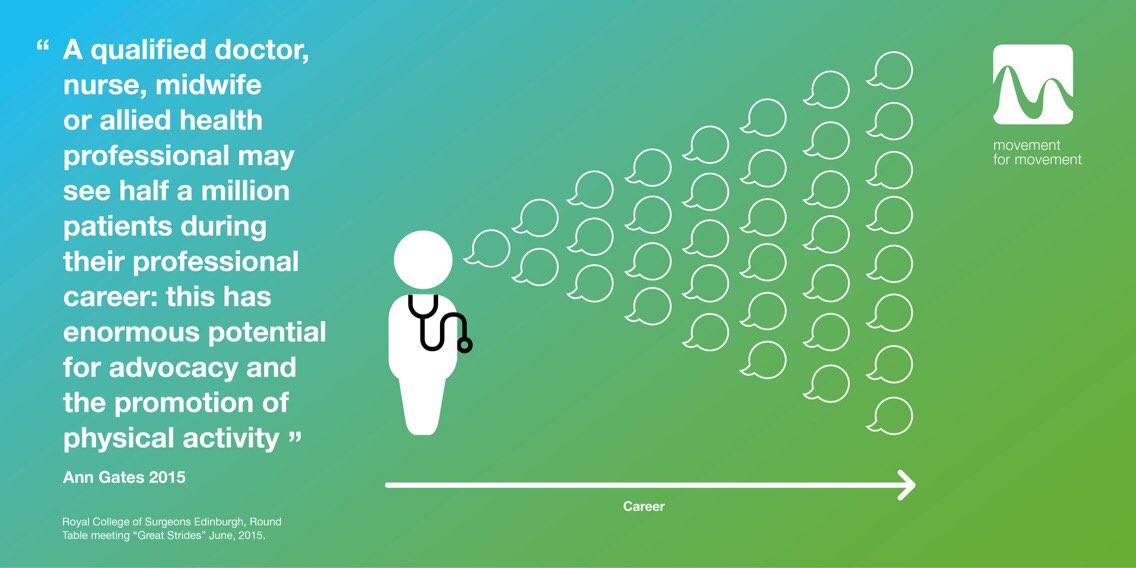By Nicole Freene @NicoleFreene
A recent Australian study found no change in physical activity levels over the last 20 years. Nearly 60% of Australian adults are not doing enough to receive the health benefits of physical activity [1].
Health professionals need to take advantage of any opportunity to promote physical activity.

In 2015, Ann Gates (@exerciseworks) and her team launched a worldwide interdisciplinary, undergraduate teaching resource on exercise medicine for the prevention and treatment of non-communicable diseases. The physical activity resources consist of national and international strategies and infographics, background introductions, specific disease and health condition slide-sets, a text module, and advice on how to use the resources effectively. They created a ‘Movement for Movement’ [2, 3]. Part of their mission states:
“A qualified doctor, nurse, midwife or allied health professional may see nearly half a million patients during their career: this has enormous potential for advocacy and the promotion of physical activity. Let’s make every contact count, for physical activity!”
At the University of Canberra we are cultivating this culture of physical activity promotion in our future physiotherapists. We aim to contribute to the movement of global health professionals that are ready to address the worldwide increase in non-communicable diseases. We have introduced the ‘Movement for Movement’ teaching resources to complement our current curriculum. Educating health professionals on the importance of physical activity is a strategy that has been clearly outlined in action plans to promote physical activity around the world [4-6].
The University of Canberra is ranked among the top 100 young universities in the world and is committed to preparing professional and highly employable graduates with the right mix of skills and knowledge. At the University of Canberra we have approximately 320 pre-qualification physiotherapists, a combination of both undergraduate (240) and postgraduate students (80).
In semester-1 2017 the ‘Movement for Movement’ disease and health condition slide-sets were made available to undergraduate and postgraduate physiotherapy students within the unit Cardiothoracic Interventions, and also distributed among the physiotherapy teaching staff. A focus of this unit is exercise-based cardiac rehabilitation. The ‘Movement for Movement’ slide-sets provide information on exercise and physical activity in heart disease and hypertension. The slide-sets also cover a number of non-communicable diseases, such as type 2 diabetes and cancer, and other conditions including pregnancy, surgery, and primary prevention of chronic disease.
Physiotherapy students were provided with the ‘Movement for Movement’ slides for review and future reference. All students were allocated time for self-directed learning to review all the slide presentations. Some of the material within the slide-sets was also covered in face-to-face lectures during the unit. Those that used the resource were asked to provide feedback via a brief survey. Students agreed that the ‘Movement for Movement’ content was engaging, presented in an interesting way and had excellent visual impact. The content in all topics increased their understanding of the benefits of physical activity and exercise; in particular, osteoarthritis, rheumatoid arthritis and dementia.
The students commented:
Really great resource for future and general understanding [of the health benefits of physical activity].
Having a background in exercise science, the material was nothing new, however it was a good refresher for me and I learnt the most from the pregnancy slides 🙂
Was presented very well. Was good for people wanting to complete at their own pace.
Great resources, thank you!
There are plans to distribute these resources more widely within the Faculty of Health to other disciplines such as Pharmacy, Nursing, and Occupational Therapy.
Physiotherapists should use their exercise specialization skills to promote physical activity in any setting. Providing the ‘Movement for Movement’ slide-sets has introduced and reinforced to our students the benefits of exercise and physical activity for a number of conditions early in their pre-qualification training. By educating our future physiotherapists at the University of Canberra to promote physical activity at any opportunity, we aim to make every contact count!
References
- Chau J, Chey T, Burks-Young S, et al. Trends in prevalence of leisure time physical activity and inactivity: results from Australian National Health Surveys 1989 to 2011. Aust N Z J Public Health 2017 doi: 10.1111/1753-6405.12699 [Published Online First: 27 July 2017].
- Gates AB. Making every contact count for physical activity–for tomorrow’s patients: the launch of the interdisciplinary, undergraduate, resources on exercise medicine and health in the U.K. Br J Sports Med 2016;50(6):322-23 doi: 10.1136/bjsports-2015-095489 [Published Online First: 19 October 2015].
- Gates AB, Kerry R, Moffatt F, et al. Movement for movement: exercise as everybody’s business? Br J Sports Med 2017;51(10):767-68 doi: 10.1136/bjsports-2016-096857 [Published Online First: 2 May 2017].
- National Heart Foundation of Australia. Blueprint for an active Australia. 2014. https://www.heartfoundation.org.au/images/uploads/publications/Blueprint-for-an-active-Australia-second-edition.pdf.
- World Health Organisation. Physical Activity Strategy for the WHO European Region 2016-2025. 2016. http://www.euro.who.int/__data/assets/pdf_file/0014/311360/Physical-activity-strategy-2016-2025.pdf?ua=1.
- World Health Organisation. Draft WHO global action plan on physical activity 2018 – 2030. 2017. http://www.who.int/ncds/governance/gappa_version_4August2017.pdf?ua=1.
**************
Clinical Assistant Professor Nicole Freene is a physiotherapist at the University of Canberra.
#Movementformovement
Ann Gates @exerciseworks